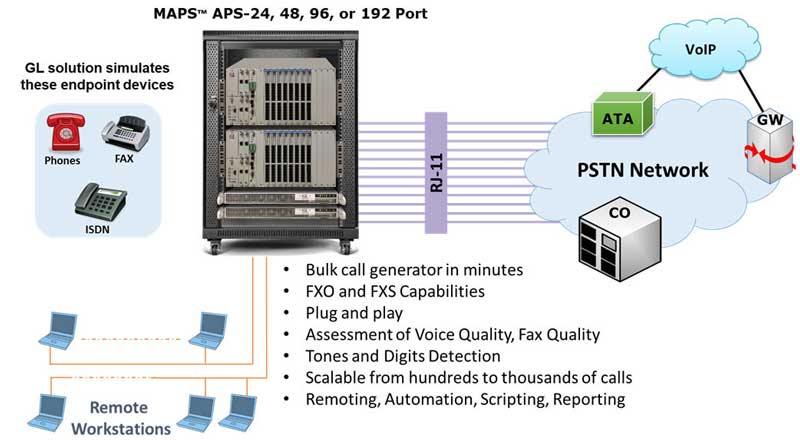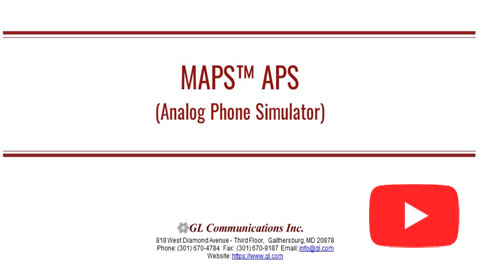MAPS™ APS
(Analog Phone Simulator)
High capacity Analog 2-Wire FXO/FXS or 4-Wire E&M Bulk Call Generator used to test a Central Office (CO), PBX, ATAs, Optical Network Terminal (ONT) / Optical Line Terminal (OLT), Gateway or other telecommunications equipment.
Request a Demo / Quote BrochureOverview
MAPS™ APS is a high capacity Analog 2-Wire FXO/FXS or 4-Wire E&M Bulk Call Generator that performs test on Central Office, PBX, Telephone Adapter, Gateway or other telecommunications equipment. It includes server hardware, GL MAPS™ software, channel bank(s), along with optional modules (Fax Emulation and Voice Quality Testing Analysis) in a compact rackmount system. MAPS™ APS system supports up to 96 independent FXO ports or FXS ports per 1U MAPS™ APS/ALS Server. More can be achieved by simply scaling the system with a 4U MAPS™ APS Server sporting 2 Octal T1 E1 Cards which can then support up to 384 analog ports.
MAPS™ APS supports Supplementary Service Testing and Interactive Voice Response (IVR) testing that recognizes and responds to voice prompts using DTMF digits or voice, allowing automated IVR traversal and testing. Provides high-density connection to any 2-wire analog interface for fully automated custom testing.
MAPS™ platform offers automated, scripted, multi-user, multi-protocol, and high capacity Bulk Call Generation. This platform is the basis for all signaling protocols and for traffic generation – whether voice, tones, digits, fax, data, or video, depending on the network support. MAPS™ covers legacy PSTN, TDM, SONET SDH, next generation VoIP, and wireless protocols, interfaces, and equipment. MAPS™ can support any of the following protocols in TDM networks for establishing the signaling links - CAS, FXO FXS, ISDN, SS7, PPP, GSM, INAP, CAP, and MAP.
Benefits of using MAPS™ APS (Analog Phone Simulator)
- High-Density Analog Port Simulation
Supports up to 384 analog ports in a scalable rackmount system, enabling bulk call testing across large-scale telecom networks - Supports Both FXO and FXS Testing
Simulates both subscriber lines (FXO) and central office lines (FXS), making it ideal for testing PBX, CO, gateways, ATAs, and OLT/ONT systems - Automated IVR Testing with Voice Recognition
Uses GL’s Speech Transcription Server to recognize and respond to voice prompts, enabling fully automated Interactive Voice Response (IVR) traversal and validation - Comprehensive E&M Signaling Support
Supports E&M Types I–V with immediate start, wink start, and delay dial signaling for legacy trunk testing in TDM and private networks - Full API & CLI Integration for Automation
Offers Python and Java APIs and command-line interface (CLI) control, allowing seamless integration into automated test frameworks and CI/CD pipelines
- Scalable & Modular Design
Easily scales from 24 to 384+ ports using modular channel banks (APSCB-24/48/96) and T1/E1 cards, adapting to growing testing needs - Advanced Voice Quality Testing (VQT) – Optional
Provides MOS scoring (PESQ, POLQA, E-Model) and voiceband measurements (SNR, gain slope, distortion) for in-depth audio performance analysis - Real-Time Call Monitoring & Recording
Enables call recording, monitoring, and failure analysis, helping engineers diagnose issues like call drops, delays, or signaling errors - Global Telephony Feature Support
Simulates region-specific tones (dial, ringback, busy), caller ID, call waiting, call forwarding, 3-way conferencing, and VMWI for real-world testing - Centralized Reporting & Detailed Analytics
Generates PDF/CSV reports with pass/fail status, failure root causes, delay metrics (post-dial, one-way), and summary dashboards for compliance and QA
These benefits make the MAPS™ APS a powerful solution for telecom equipment manufacturers, service providers, and R&D labs needing reliable, automated, and high-capacity analog and E&M interface testing.
Key Features
- Test Central Office, PBX, Gateway, Analog/Digital/VoIP networks
- MAPS™ APS support testing of Optical Network Terminal (ONT) / Optical Line Terminal (OLT)
- Support testing of Gigabit Passive Optical Network (GPON OLT) unit using MAPS™ APS as FXO emulator
- Manual and automated bulk analog call simulation
- Call monitoring and call recording
- Concurrent users and tests per system
- Interactive Voice Response (IVR) using GL Speech Transcription Server
- API support (Python, Java) for integration with automation frameworks
- Supports E&M (Type I, II, III, IV, V) signaling - immediate start, wink start, delay start
FXO Capabilities - Subscriber Call Generator
- Up to 192 independent subscriber FXO ports per 1U MAPS™ APS (More can be achieved by scaling)
- Full FXO functionality via flexible scripts
- Supported call scenarios
- Caller ID
- Two-way calling
- Three-way conference calling
- Three-way calling with calling party number ID
- VMWI (Visual message waiting indicator) & SDT (stutter dial tone) detection
- Call Waiting – detect call waiting tone and caller ID, flash to accept call
- Call Forwarding
FXS Capabilities
- Up to 96 independent FXS ports per 1U MAPS™ APS (more can be achieved by scaling)
- Central office simulation with two-way calling
- User-programmable call progress tone generation for different countries/regions:
- Dial tone
- Ringback tone
- Busy tone
- Reorder tone
- Howler tone (extended off-hook signal)
- Ring generation with programmable ring cadence
Reporting
- Executed test cases
- Successful test cases
- Call failure events
- Call completion events
- Call drop (sustain calls) events
- Voice Quality Test MOS scores
- Delay measurements (one-way delay, post-dial delay)
- Pass/fail status
- Summarization
- Failure details sufficient to determine root cause
- Report generation supports PDF and CSV file formats
- Central database of events/results/errors
Voiceband Measurement Capabilities for VG3 and VG6
- Voice Quality Test (VQT)
- Voiceband Measurement Capabilities for VG3 and VG6
- Signal-to-Noise Ratio and Level
- Three Tone Slope (Gain Slope)
- C Notched Noise (CNN) Test
- 1004 Hz Net Loss
- Attenuation Distortion
- Intermodulation Distortion (IMD)
- Impulse Noise
Command Line Interface (CLI) Capabilities
- Fully automated with CLI/API and external control
- Remote accessible via CLI/API
- TCP/IP based Client/Server application
- Script-based call simulation and control
- Comprehensive API for call flow control and feature testing
- API for Python and Java
- Allows multiple clients to be connected simultaneously
- Reserve/release analog lines through API
- Independent execution available for all lines
Functionalities
- Basic Telephony functions - on-hook, off-hook, detect ringing signal, dial, hook flash
- Digit related functions - send and detect digits
- File transfer functions - send and receive voice file
- Tone related functions - detect busy tone, call waiting tone, dial tone, reorder tone, ring-back tone, special dial tone, send and detect 1004 Hz test tone
- Fax related functions - send and receive fax
- FSK related functions - detect caller ID, VMWI
- VQT (Optional) - MOS, E-Model, PESQ, POLQA scores
Frequently Asked Questions
- What is the MAPS™ APS used for?
- The MAPS™ APS is a high-capacity analog call generator used to test telecommunications equipment such as Central Offices (CO), PBX systems, gateways, ATAs, OLT/ONT, and GPON networks. It simulates bulk analog (FXO/FXS) or 4-wire E&M calls for automated functional, regression, and performance testing.
- How many analog ports can the MAPS™ APS support?
- The system supports up to 384 analog ports. A single 1U server can handle up to 96 ports, and larger configurations with dual Octal T1/E1 cards scale to 192–384 ports using multiple channel banks.
- What types of signaling does MAPS™ APS support?
-
It supports:
- 2-wire analog: FXO and FXS signaling
- 4-wire E&M: Types I, II, III, IV, and V with immediate start, wink start, and delay dial supervision
- Supplementary services: Caller ID, call waiting, forwarding, conferencing, VMWI
- Can MAPS™ APS perform IVR (Interactive Voice Response) testing?
- Yes. Using GL’s Speech Transcription Server, MAPS™ APS can recognize voice prompts and respond via DTMF or voice, enabling fully automated IVR traversal and validation.
- Does it support fax testing?
- Yes. With the optional Fax Emulation module, MAPS™ APS can send and receive faxes, making it suitable for testing fax over analog lines in legacy and VoIP environments.
- Is the system automated and scriptable?
- Yes. MAPS™ APS offers Python and Java APIs and a Command Line Interface (CLI) for full automation. It integrates with external test frameworks and supports custom scripts for call flows and feature testing.
- Can I simulate both subscriber (FXO) and central office (FXS) roles?
-
Yes. The system can act as:
- FXO (subscriber): Simulating phones calling into a CO or PBX
- FXS (central office): Providing dial tone and ringing to devices like ATAs or fax machines
- What kind of reporting does MAPS™ APS provide?
-
It generates detailed reports including:
- Pass/fail status
- Call success/failure events
- Voice Quality Test (VQT) scores (MOS, PESQ, POLQA)
- Delay measurements (post-dial, one-way)
- Root cause analysis of failures
- Exportable in PDF and CSV formats
- Is voice quality testing available?
-
Yes, Voice Quality Testing (VQT) is an optional feature that provides:
- MOS scoring via PESQ, POLQA, and E-Model
- Voiceband measurements (SNR, gain slope, distortion, noise)
- Ideal for compliance and performance benchmarking
- How does the system connect to the device under test?
- The MAPS™ APS server connects via T1/E1 digital links to APSCB channel banks (e.g., APSCB-24, -48, -96), which convert digital signals to analog 2-wire or 4-wire E&M interfaces. These connect to patch panels or breakout boxes for physical access to individual ports.
- Can I test E&M signaling with wink start or delay dial?
-
Yes. MAPS™ APS supports all three E&M dial supervision methods:
- Immediate Start
- Wink Start
- Delay Dial
These can be configured through E&M profiles in the software.
- What hardware is included in a typical MAPS™ APS setup?
-
A standard configuration includes:
- 1U or 2U rackmount Xeon server running MAPS™ software
- Quad or Octal T1/E1 card
- APSCB series channel bank (24 to 96 ports)
- Optional VQT server and fax modules
- Cables and breakout boxes as needed
- Can multiple users access the system simultaneously?
- Yes. The TCP/IP-based client/server architecture allows multiple users and concurrent tests, making it ideal for shared lab environments and team-based testing.
- Does it support international telephony standards?
- Yes. The system supports programmable call progress tones (dial, ringback, busy) and signaling for various countries and regions, ensuring global compatibility.
Working Principle
The MAPS™ APS server connects to the APSCB24/48 via a Quad T1 card and digital calls are generated to the APSCB24/48 using the MAPS™ APS CLI or GUI. The APSCB24/48 converts the digital calls to analog and simulates standard analog telephones. Each digital call signals analog offhook with DTMF dialed digits from the APSCB24/48. Both outgoing and incoming analog calls are supported. The connection to the APSCB24/48 includes a standard 50-pin Amphenol telco connector, which can be connected to a breakout box or patch panel that supports up to 24 2-wire interfaces. Each of the analog ports serves as an independent analog telephone, which can be individually configured and activated for various telephony tasks. The calls can be monitored and recorded for voice quality analysis.
Thus, MAPS APS uses a Quad T1 card and two sets of APSCB48 and patch panels to achieve a max of 96 analog ports. More can be achieved by simply scaling the system with a 4U MAPS™ APS server sporting 2 Octal T1 E1 cards which can support up to 384 analog ports.
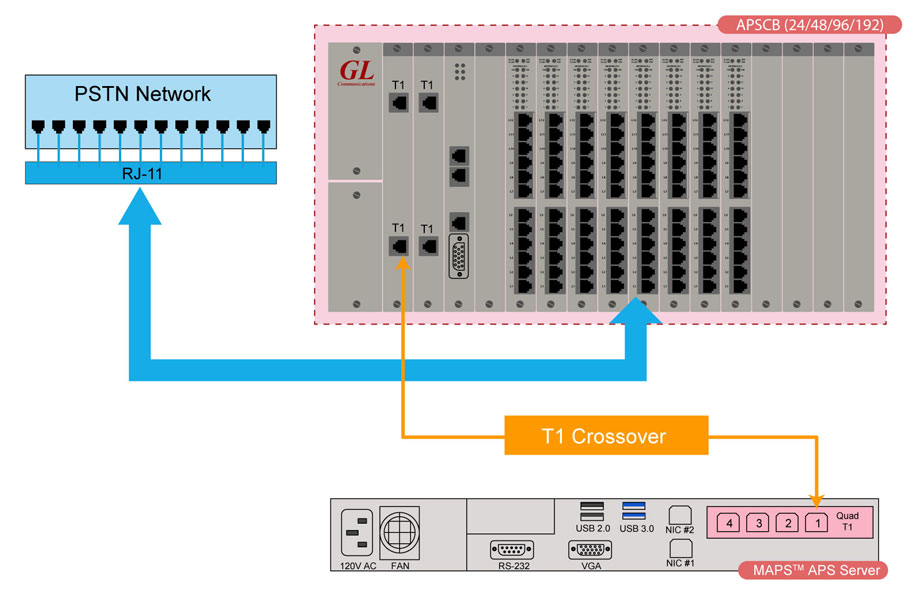
MAPS™ APS-Functional Diagram
Functional Specifications
FXO Capabilities |
|
FXS Capabilities |
|
Operation |
|
Traffic |
|
Reporting |
|
Fully Automated with CLI and external control |
|
Basic Telephony functions |
|
Digit related functions |
|
File transfer functions |
|
Tone related functions |
|
Fax related Functions |
|
FSK related functions |
|
Audio Analysis |
|
Hardware Specifications
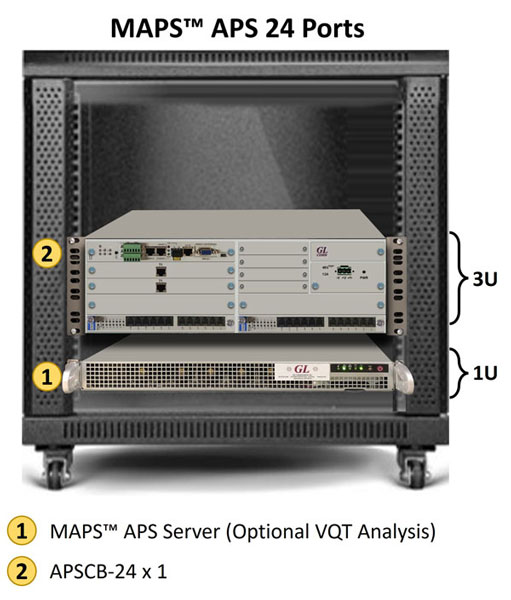
| Hardware Specifications |
|---|
19" 1U Xeon Rack PC - MAPS™ APS
19" 1U Xeon Rack PC - VQT (Optional) 1x APSCB-24 Channel Bank
|
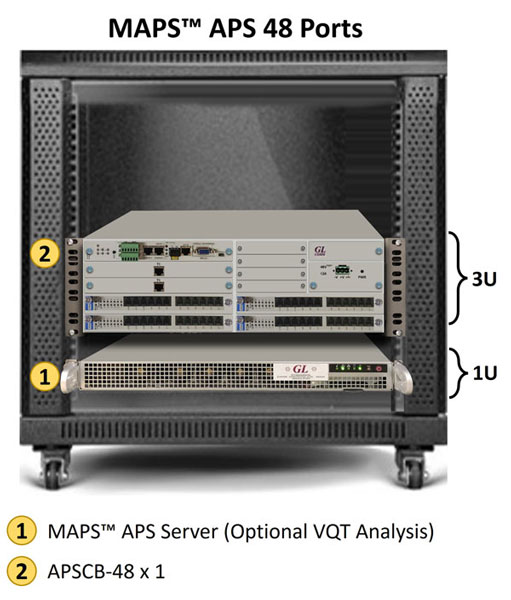
| Hardware Specifications |
|---|
19" 1U Xeon Rack PC - MAPS™ APS
19" 1U Xeon Rack PC - VQT (Optional) 1x APSCB-48 Channel Bank
|
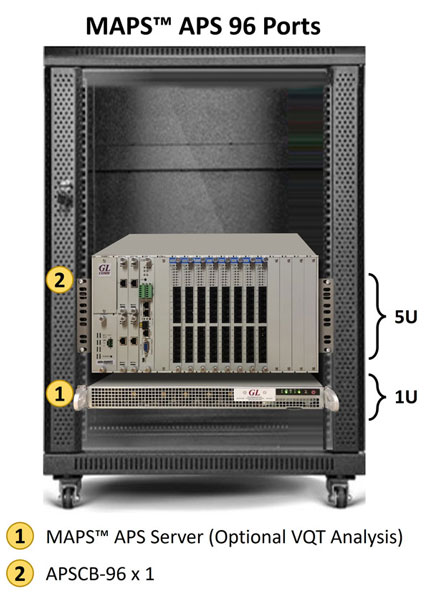
| Hardware Specifications |
|---|
19" 1U Xeon Rack PC - MAPS™ APS
19" 1U Xeon Rack PC - VQT (Optional) APSCB-96 Channel Bank
|
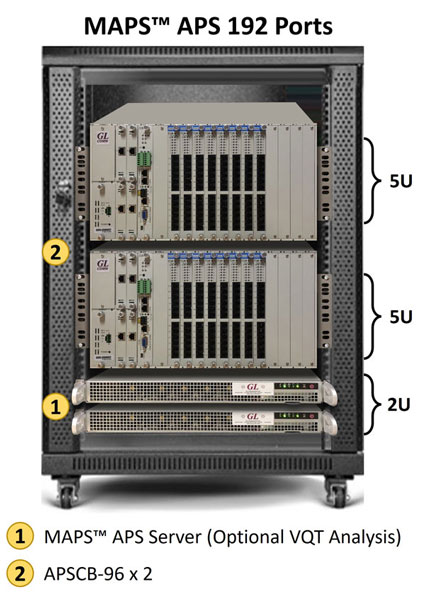
| Hardware Specifications |
|---|
19" 1U Xeon Rack PC - MAPS™ APS
19" 1U Xeon Rack PC - VQT (Optional) 2x APSCB-96 Channel Bank
|
MAPS™ APS E&M
A channel bank is required to provide analog 4-wire E&M interfaces. Without a channel bank, MAPS APS will perform the signaling required to simulate E&M signaling. The connection diagram below shows an Adit 600 channel bank with E&M service cards.
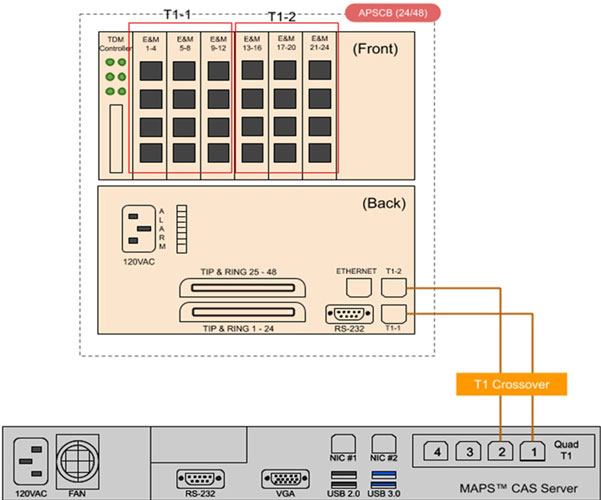
MAPS™ APS E&M Functional Diagram
Each E&M service card provides four female RJ-45 connectors. Each T1 supports 3 E&M service cards for a total of 12 E&M interfaces. The pin-out for the RJ-45 connector is shown below.
| Normal Mode (Terminating/Channel Equipment) | Tandem Mode (Originating/Switching Equipment) | ||
|---|---|---|---|
| Pin | Name | Pin | Name |
| 1 | SG (Signal Ground) | 1 | SG (Signal Battery) |
| 2 | E | 2 | M |
| 3 | R1 | 3 | R1 |
| 4 | R | 4 | R |
| 5 | T | 5 | T |
| 6 | T1 | 6 | T1 |
| 7 | M | 7 | E |
| 8 | SB (Signal Battery) | 8 | SG (Signal Battery) |
E&M Signaling Types I, II, III, IV, and V are supported by the E&M service card.
Dial Supervision Signaling
Three types of start dial supervision signaling are supported and can be selected via the E&M Profiles in MAPS APS.
Immediate Start: The originating side goes offhook, waits for a finite period then sends the dial digits to the far end.
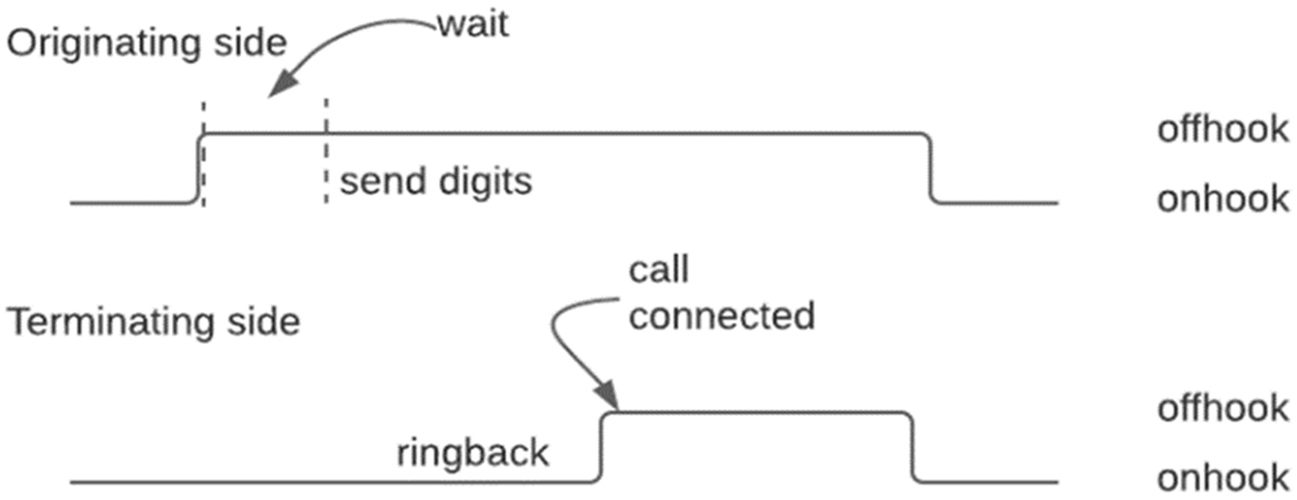
E&M Immediate Start Signaling
Wink Start: The originating side goes offhook, waits for a temporary offhook pulse from the other end, then sends the dial digits.
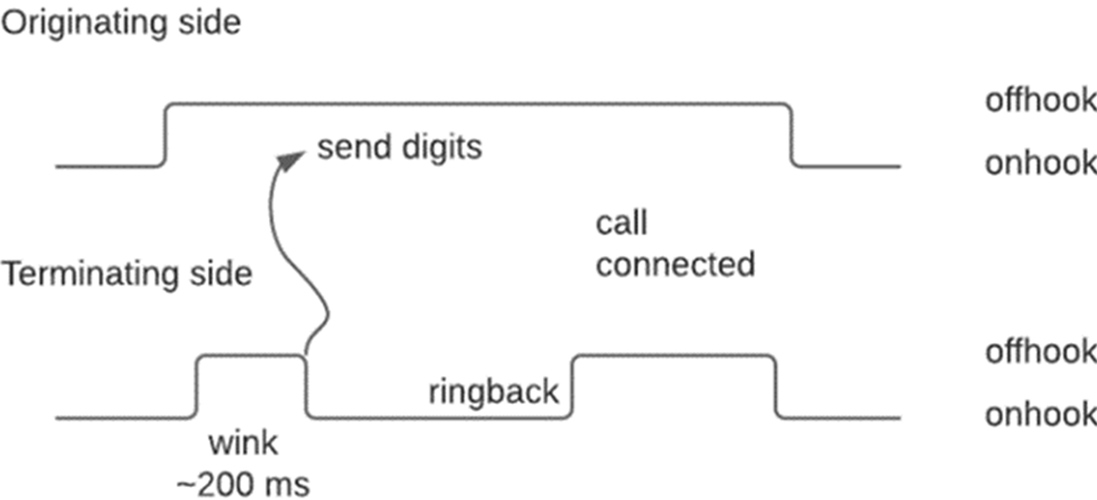
E&M Wink Start Signaling
Delay Dial: The originating side goes offhook and waits for about 200 ms, then checks to see if the far end is onhook. If the far end is onhook then it sends the dial digits. If the far end is offhook, it waits until it goes onhook then sends the dial digits.
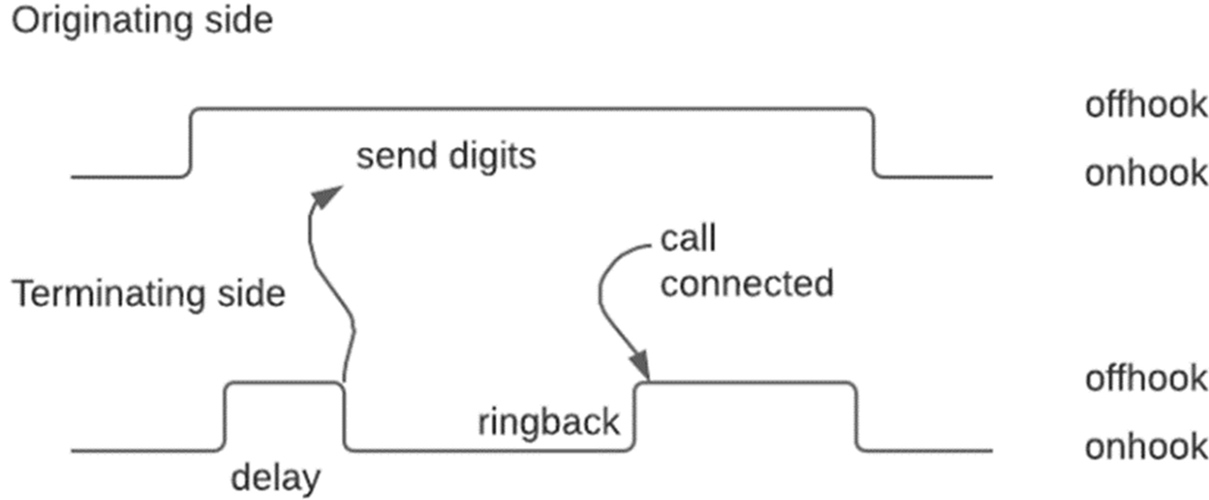
E&M Delay Dial Signaling
The below image shows the simulation of E&M Originating Call
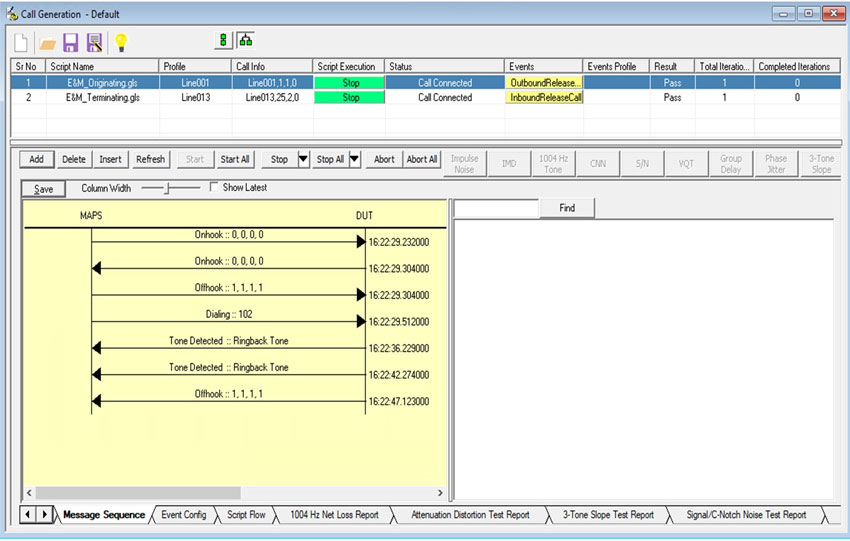
Call Simulation E&M
Resources
Note: PCs which include GL hardware/software require Intel or AMD processors for compliance.
Please Note: The XX in the Item No. refers to the hardware platform, listed at the bottom of the Buyer's Guide, which the software will be running on. Therefore, XX can either be ETA or EEA (Octal/Quad Boards), PTA or PEA (tProbe Units), XUT or XUE (Dual PCIe Express) depending upon the hardware.
| Item No. | MAPS™ for TDM Network (requires T1 or E1 Hardware and Basic Software) |
|
Hardware |
|---|---|
MAPS™ APS 24 Port |
DP005B - Rackmount PC, 1U 19", Xeon - Standard |
MAPS™ APS 48 Port |
DP005B - Rackmount PC, 1U 19", Xeon - Standard |
MAPS™ APS 96 Port |
SA005r - Rackmount PC, 2U 19", Xeon - Standard |
MAPS™ APS 192 Port |
SA005r- Rackmount PC, 2U 19", Xeon - Standard |
MAPS™ ALS 48 Port |
SA005r - Rackmount PC, 2U 19", Xeon - Standard |
MAPS™ ALS 96 Port |
SA005r - Rackmount PC, 2U 19", Xeon - Standard |
| 2-Wire APS – FXO or FXS or Combination | |
| APSCB-24-2W | 24-Port 2W Analog Phone Simulator (APS), or Central Office Switch Simulator |
| APSCB-48-2W | 48-Port 2W Analog Phone Simulator (APS), or Central Office Switch Simulator |
| APSCB-72-2W | 72-Port 2W Analog Phone Simulator (APS), or Central Office Switch Simulator |
| APSCB-96-2W | 96-Port 2W Analog Phone Simulator (APS), or Central Office Switch Simulator |
| APSCB-120-2W | 120-Port 2W Analog Phone Simulator (APS), or Central Office Switch Simulator |
| 4-Wire APS – FXO or FXS or Combination | |
| APSCB-24-4W | 24-Port 4W Analog Phone Simulator (APS), or Central Office Switch Simulator |
| APSCB-48-4W | 48-Port 4W Analog Phone Simulator (APS), or Central Office Switch Simulator |
| APSCB-72-4W | 72-Port 4W Analog Phone Simulator (APS), or Central Office Switch Simulator |
| APSCB-96-4W | 96-Port 4W Analog Phone Simulator (APS), or Central Office Switch Simulator |
|
Software |
XX651 |
|
XX649 |
|
XX648 |
|
PKS120 |
|
PKS111 |
|
| PKS112 | Message Session Relay Protocol for MAPS-SIP |
| PKS170 | CLI Support for MAPS™ |
|
TDM Traffic Options |
XX610 |
File based Record/Playback |
XXXFT0 |
Fax Emulation |
VBA038 |
|
|
RTP Traffic Options |
PKS102 |
RTP Soft Core (additional) |
PKS200 |
RTP Pass Through Fax Emulation |
PKS211 |
T.38 Fax Simulation |
PKV104 |
|
PCD103 |
Optional Codec - AMR - Narrowband (requires additional license) |
PCD104 |
Optional Codec - EVRC (requires additional license) |
PCD105 |
Optional Codec - EVRC-B (requires additional license) |
PCD106 |
Optional Codec - EVRC-C (requires additional license) |
PCD107 |
Optional Codec - AMR - Wideband (requires additional license) |
PCD108 |
Optional Codec - EVS (requires additional license) |
| PCD109 | Optional Codec - Opus (requires additional license) |
|
Voice Quality |
VQT002 |
|
VQT006 |
|
| Brochures |
|---|
| 2-Wire Analog and 4-Wire E&M Bulk Call Generator Brochure |
| MAPS™ CAS Brochure |
| MAPS™ FXO FXS Brochure |
| Product Webinar |
|---|
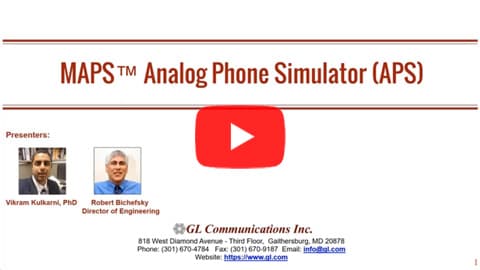 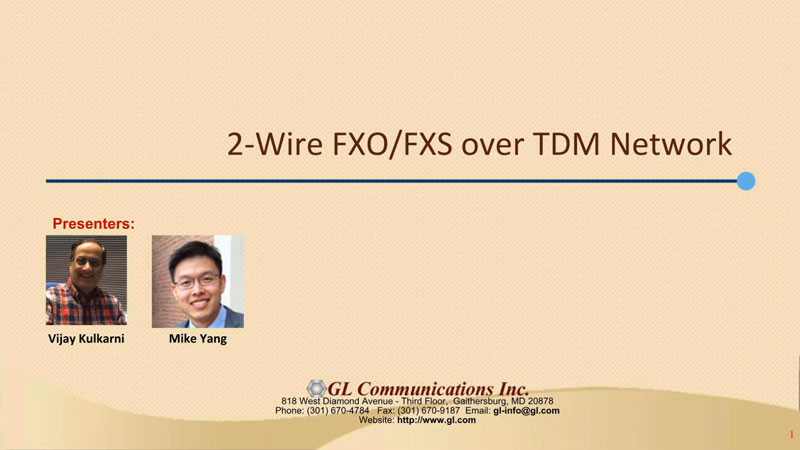
|
